Pork Belly
Moderator
Panchetta Tessa (Flat) is prepared the same as traditional rolled panchetta it is just not rolled.
Start with the Basic Dry Cure From Michael Ruhlman's Book Charcuterie
Everybody doesn't have a scale so I listed different measuring options.
Basic Dry Cure
1Pound or 450 grams Kosher Salt
8 oz. or 225 Grams Sugar
2 oz. or 50 grams or 10 teaspoons Pink Salt- Sodium Nitrite
For this batch I used a 3.5 pound section of Pork Belly.
The belly was place in a large bowel and dry cure added. Rub the cure in until it is evenly coatted, discarding any excess.
Prepare the following:
Dice then crush one head of Fresh Garlic
Toast 1 Tablespoon each of Juniper Berries and whole black peppercorns, then grind in a spice grinder until course.
Apply the garlic and juniper/pepper mixture evenly to all sides of the meat. Seal the belly in a zip top bag for seven days. While still sealed in the bag flip the belly top to bottom every day for seven days.
On the seventh day rinse with cool water just long enough to remove the curing salt, all of the spice bits will not come off this is fine. Pat the belly dry, it is optional to apply a dusting of course ground black pepper at this time. Hang the section of belly either with a bacon hanger of by piercing with a knife and trying secure loops with butcher twine.
The Panchetta is ready to eat at this time but is better as it ages and looses additional moisture. hang it in a cool dry place out of direct sunlight. The basement of a walk-in pantry is great, However I have often just left them hing on a cabinet knob in the kitchen. I once made a rolled Panchetta that was about 8 pounds. It hung on the cabinet knob until it was used up through a few months.
The picture of the pile of cure on the belly shows about one large hand full of cure, maybe 2/3 of a cup. This is one of the reasons I love the dry cure method, you only have to be exact when you make the cure.
The meat shows you how much to use. Dump the cure on, rub it in get rid of the excess, it always works.
This is where I get my Juniper Berries, one pound is more than quart of berries.
http://www.butcher-packer.com/index.php?main_page=product_info&products_id=887
Start with the Basic Dry Cure From Michael Ruhlman's Book Charcuterie
Everybody doesn't have a scale so I listed different measuring options.
Basic Dry Cure
1Pound or 450 grams Kosher Salt
8 oz. or 225 Grams Sugar
2 oz. or 50 grams or 10 teaspoons Pink Salt- Sodium Nitrite
For this batch I used a 3.5 pound section of Pork Belly.
The belly was place in a large bowel and dry cure added. Rub the cure in until it is evenly coatted, discarding any excess.
Prepare the following:
Dice then crush one head of Fresh Garlic
Toast 1 Tablespoon each of Juniper Berries and whole black peppercorns, then grind in a spice grinder until course.
Apply the garlic and juniper/pepper mixture evenly to all sides of the meat. Seal the belly in a zip top bag for seven days. While still sealed in the bag flip the belly top to bottom every day for seven days.
On the seventh day rinse with cool water just long enough to remove the curing salt, all of the spice bits will not come off this is fine. Pat the belly dry, it is optional to apply a dusting of course ground black pepper at this time. Hang the section of belly either with a bacon hanger of by piercing with a knife and trying secure loops with butcher twine.
The Panchetta is ready to eat at this time but is better as it ages and looses additional moisture. hang it in a cool dry place out of direct sunlight. The basement of a walk-in pantry is great, However I have often just left them hing on a cabinet knob in the kitchen. I once made a rolled Panchetta that was about 8 pounds. It hung on the cabinet knob until it was used up through a few months.
The picture of the pile of cure on the belly shows about one large hand full of cure, maybe 2/3 of a cup. This is one of the reasons I love the dry cure method, you only have to be exact when you make the cure.
The meat shows you how much to use. Dump the cure on, rub it in get rid of the excess, it always works.
This is where I get my Juniper Berries, one pound is more than quart of berries.
http://www.butcher-packer.com/index.php?main_page=product_info&products_id=887






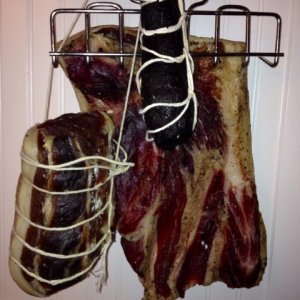
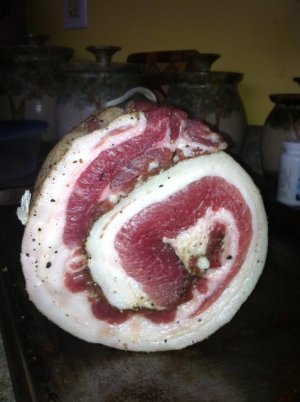
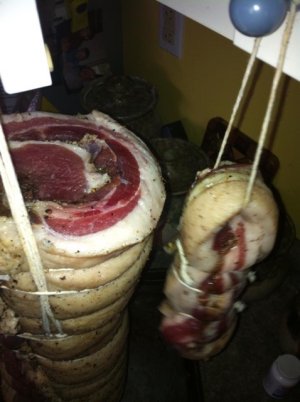


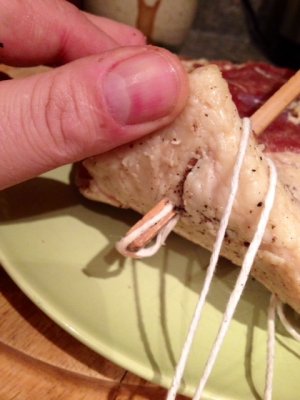

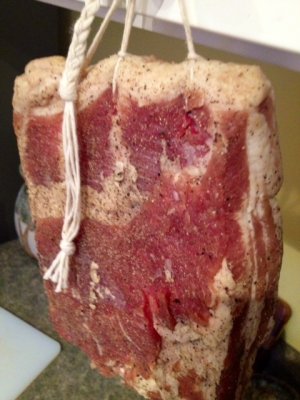
 looks really good. How do you keep it away from the dog? ;D
looks really good. How do you keep it away from the dog? ;D